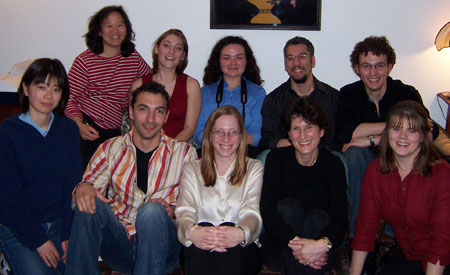| |
| |
| Susan Wray, Ph.D., Senior Investigator |
 |
Dr. Wray received her B.A. degree from Middlebury College and her M.S, and Ph.D. degrees from University of Rochester School of Medicine & Dentistry where she worked on development of neuroendocrine systems associated with puberty. She continued her work on neuroendocrine systems as a postdoctoral fellow with Harold Gainer in NICHD. In 1992 she became a faculty member of NINDS as a Unit Chief in the Laboratory of Neurochemistry and in 1999 became Chief of the newly created Cellular and Developmental Neurobiology Section. She is a council member of the International Society of Neuroendocrinology and a founding member of the American Neuroendocrine Society. Dr. Wray's laboratory is studying developmental cues underlying neuronal migration, and neurogenesis and regulation of neuroendocrine cells essential for reproduction.
|

|
Staff:

- Claudia Caligioni, Ph.D., Postdoctoral Fellow caligionic@ninds.nih.gov
- Filippo Casoni, Ph.D., Postdoctoral Fellow casonif@ninds.nih.gov
- Stephanie Constantin, Ph.D., Postdoctoral Fellow ConstanS@mail.nih.gov
- Paolo Forni, Ph.D., Postdoctoral Fellow fornip@ninds.nih.gov
- Kimeya Fatemeh Ghaderi, Newcomb Fellow ghaderik@mail.nih.gov
- Ulrike Klenke, Ph.D., Postdoctoral Fellow klenkee@mail.nih.gov
- Hillery Metz, Post baccalaureate Fellow metzh@od.nih.gov
- Jean R Tiong, Ph.D., Biologist, (301) 496-8131 Tiongj@ninds.nih.gov
Research Interests:
CDNS conducts fundamental research on neurogenesis of placodally derived neurons and regulation of neuroendocrine cells. Our focus is on development and regulation of LHRH neurons, which are neuroendocrine cells essential for reproduction. Alterations in normal development or regulation of the LHRH system results in reproductive dysfunctions. Developmentally, LHRH neurons originate outside the CNS, in the nasal placode, and thereafter migrate into the brain. Once within the brain, LHRH neurons become integral components of the hypothalamic-pituitary-gonadal axis and exhibit pulses of LHRH secretion approximately once an hour in reproductively mature animals.
Our ability to systematically manipulate the molecular and cellular biology of the developing LHRH system opens the route to understanding critical neurobiological issues such as phenotypic commitment and mechanisms involved in neuronal migration. In addition, the mechanisms regulating LHRH gene and peptide expression, as well as peptide secretion are being examined to decipher the cellular characteristics underlying neuroendocrine function.
Research models include nasal explants, hypothalamic slice cultures, immortalized LHRH cell lines, and normal and transgenic animals. Multidisciplinary approaches are used to: 1) localize cell surface components which act as molecular guides for neuronal migration, 2) identify neuronal phenotypes which are derived from olfactory placode and the lineage relationship between them and, 3) create single cell libraries from neurons at different developmental stages for isolation of candidate �migrational� or �differentiation� genes and 4) measuring changes in LHRH mRNA levels and LHRH secretion determine cellular properties of LHRH cells underlying pulsatile secretion.
|
Selected Recent Publications:
Tiong J, Locastro T, Wray S (2007) Gonadotropin-releasing hormone -1 (GnRH-1) effects development and biomineralization of tooth, Developmental Dynamics .
Giacobini P, Messina A, Wray S, Giampietro C, Crepaldi T, Carmeliet P, Fasolo A (2007) Hepatocyte Growth Factor Acts as a Motogen and Guidance Signal for Gonadotropin Hormone Releasing Hormone-1 (GnRH-1) Neuronal Migration, J. Neuroscience.
Giacobini P, Wray S (2007) Cholecystokinin Directly inhibits Neuronal Activity of Gonadotropin Releasing hormone cells (GnRH-1) through CCK-1R, Endocrinology.
Lee J, Maddox DM, Condie BG, Wray S (2007) Accelerated migration of GnRH-1 neurons in GAD 67 knockout mice, J of Neuroendocrinology.
Cogliati T, Delgado-Romero P, Norwitz, ER, Guduric-Fuchs J, Kaiser UB, Wray S,Kirsch IR (2007) Pubertal impairment in Nhlh2 "null" mice is associated with hypothalamic and pituitary deficiencies, Molecular Endocrinology .
Constantin S, Wray S (2007) GnRH-1 Neuronal activity is independent of cyclic nucleotide gated channels, Endocrinology.
Toba Y, Tiong JD, Ma Q, Wray S (2007) CXCR4/SDF-1 system modulates development of GnRH-1 neurons and the olfactory system, Development Neurobiology.
All Selected Publications
Contact Information:
Dr. Susan Wray
Cellular and Developmental Neurobiology Section, NINDS
Porter Neuroscience Research Center
Building 35, Room 3A-1012
35 Convent Drive, MSC 3703
Bethesda, MD 20892-3703
Telephone: (301) 496-6646 (office),
(301) 496-8129 (laboratory),
(301) 496-8578 (fax)
Email: wrays@ninds.nih.gov
|
|















